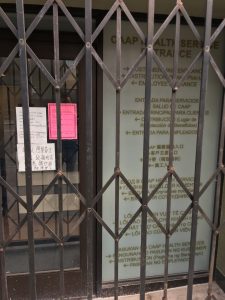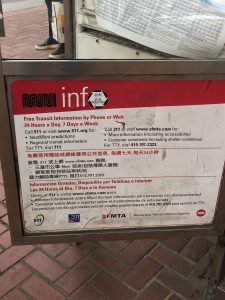Before coming to San Francisco, I was not expecting anything more distinctive from any other cities in the United States that I have been to. However, after three weeks of immersion and observations, I think San Francisco indeed enjoys incomparable diversity in both culture and languages. Just a few blocks of walking distance uphill from the financial district lies one of the oldest Chinatowns in the world. Starting from there, if someone proceeds westbound for another twenty minutes or so, he or she can expect an iconic Japantown surrounded by a large African American community. On the other hand, Tagalog as a Filipino official language now ranks as the third top spoke non-English language after Chinese and Spanish, and as one walks down the bustling Mission Street, many different languages other than the aforementioned ones can be heard. Indeed, English is the dominant language here and there are heavy commodification of non-English languages throughout San Francisco, but this city’s linguistic landscape also pays respects to other non-English languages throughout many details around one’s daily life.
Even though San Francisco enjoys a diverse culture marked by its ethnic composition and multiple languages, it lies under the context of an American city within the United States, a country whose official language is English. Therefore, the majority of the signs such as the time-specific no-parking signs are written only in English and the same applies to Chinatown and Japantown without exception. On the BART transit system spanning across the entire bay area, there seldom are cases when station names are displayed and broadcasted in languages other than English. The only case when I can observe where languages other than English show up is the safety information board in the metro station.
For the example of the Chinatown in Washington DC, Leeman and Modan argue that ‘the use of Chinese in the current landscape promotes an exotified landscape that appeals to an outsider’s perspective’ (Leeman and Modan, 358). The same thing happens to the Chinatown and Japantown here in San Francisco. They each have translated road names in their premises. Moreover, one popular Vietnamese restaurant with located just on the outermost street of Chinatown uses English to appeal American customers from the affluent Financial District nearby, and one conspicuous guide sign within a shopping mall in Japantown employs Japanese translations to create a feeling of real-world Japan experience. Unfortunately, the corresponding Japanese translation is totally wrong in terms of what it is trying to convey.

A Vietnamese restaurant with both Chinese and English representations

A guide sign in Japantown, with wrong Japanese letters
Nevertheless, signs of inclusiveness based on respect for the non-English speakers can also be observed. When I head towards the metro station for work every day, I always walk pass by a government’s human services agency. This agency has its name, operating hours and rules written on the outside in English, Spanish, Russian, Vietnamese and Tagalog. Every morning, people of different races and various backgrounds can be seen lining up at the front door waiting to get things done. While I was using the MUNI transit system within San Francisco for the past three weeks, I can see that there are always signs showing crucial information regarding commuting within the city in the top three languages spoken for every bus stop or metro station.

Government agency with multiple languages’ translation

Important info with English, Spanish and Chinese
Last but not the least, official agencies and signs are only provided in English with their considerations of English as the official language in an American city. On the other hand, businesses of specialty cuisines or cultural products in Japantown or Chinatown or elsewhere commercialize their respective languages for businesses purposes, aligning with Leeman and Modan’s descriptions of the scenarios in Chinatown in Washington DC. However, through examples of certain government agencies and minor details around people’s life here, we can also see examples where languages other than English such as Spanish and Chinese do not lose its fundamental value of representations of intercultural communication.
Works Cited:
“Tagalog Certified As Third Language To Be Used In SF City Services Communications.” CBS San Francisco, ]2 Apr. 2014, sanfrancisco.cbslocal.com/2014/04/02/tagalog-certified-as-third-language-to-be-used-in-sf-city-services-communications/.
Leeman, J & Modan, G. (2009), Commodified language in Chinatown: a contextualized approach to a linguistic landscape. Journal of Sociolinguistics, 13(3), 358.
Really interesting essay! it’s cool how there are some links between your description of san Francisco’s linguistic landscape and the landscape of D.C. described in the reading (shown through your discussion of Chinatown and Japantown). Obviously writing in Chinese and Japanese in these areas’s bring some sense of authenticity.
Hi! I loved reading your essay, I think you did a really good job showing the balance between the use of language to make money and the increased usage showing the respect for other cultures and languages in the United States, specifically San francisco.
I agree that many restaurants incorporate foreign languages into their restaurants’ names to convey a sense of culture, thus piquing the customers’ interests. Your experience in SF is similar to my experience in Hong Kong as both establish a multilingual community. The thing that surprised me the most is the government’s human services agency that incorporates so many languages in its sign.
Very interesting essay! I am surprised that there aren’t translations for BART station names in SF, because it is very common to see translated station name in a international city, especially for those immportant means of transportation.
I think that the translation in Japantown you showed in essay is not simply a “wrong translation.” The Japanese words in the picture means “the food court of taste”. “味覚” for “taste” and “のれん街” for “the food court”. Maybe you have learned Japanese and know “の” usually means ” ‘s ” in Japanese, but for here “のれん街” is a single word and “の” does not work as ” ‘s “.
It is interesting to learn that Tagolog ranks as the top third language used in SF. As someone who lived in New York City where it is so diverse, it is even questionable what is the top three languages. The top three languages really show what is the demography of SF. Nevertheless, main languages represented in big community towns such as Chinatown and Japantown did not make it to the top top. It makes me wonder whether the top language spoken groups are more assimilated into the American culture and contribute to the overall unique SF culture without concentrating their unique culture in a small part of the city.